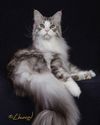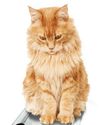Joins the Lineup of Pet Recovery Tools.

Facial recognition is a new tool for pet recovery available to dog and cat owners. Now a lost cat or dog may be just a smartphone away. Two companies, Finding Rover and PiP (which stands for Positive Identification of Pet), have developed pet facial recognition applications (“apps”) to help reunite lost pets with their owners. Fanciers can use these alternative pet identification apps on iPhone® and Android™ platforms in several countries including the United States, Canada, and Australia. Finding Rover also works on the internet. These smartphone apps avoid some of the issues associated with other pet recovery technologies. They are not dependent on collars and tags that can be lost, microchips that can migrate or fail, or tattoos that can fade. Although avoiding these pitfalls, these apps are similar to the microchip animal identification system in some ways and are different in other ways.
Both apps involve unique identifiers and a database. Unlike microchips, however, there are no invasive procedures to implant any technology in a pet or surgery to remove it. Animal Control and other pet finders do not need any specialized equipment like the universal scanners needed to read microchips. All that is needed is a smartphone, or a camera and computer hooked up to the internet – technology that people frequently have on hand.
So, how does this type of facial recognition work?
Denne historien er fra February 2017-utgaven av Cat Talk.
Start din 7-dagers gratis prøveperiode på Magzter GOLD for å få tilgang til tusenvis av utvalgte premiumhistorier og 9000+ magasiner og aviser.
Allerede abonnent ? Logg på
Denne historien er fra February 2017-utgaven av Cat Talk.
Start din 7-dagers gratis prøveperiode på Magzter GOLD for å få tilgang til tusenvis av utvalgte premiumhistorier og 9000+ magasiner og aviser.
Allerede abonnent? Logg på

Life With Patrick
Patrick and Mount Doom

Feline Photographers Part 1
\"Cats never strike a pose that isn't photogenic.\" - Lillian Jackson Braun

The Cat Fancy Alphabet
\"The Cat Fancy Alphabet\" is a new feature in Cat Talk. It highlights various terms and aspects of the cat fancy, educating fanciers new and old about our hobby.

UP CLOSE AND Purr-sonal
If there is one person, or even just a name, that anyone in CFA (Cat Fancier Association) knows, it would have to be Allene Tartaglia. It might be from her involvement with most aspects of the operations of CFA in her position of executive director. Or perhaps from her deep involvement with both the CFA Annual meeting and/or the International Show. Cat Talk thought it was time to learn more about one of the most key people in CFA.

Vision and Hearing Dysfunctions in Senior Cats
Just as people are challenged by having deficiencies with vision and hearing over time, so are senior cats. In senior cats, pet owners may notice their cats are no longer responding to them in the same way; however, it may be difficult to figure out.

Senior Cats and House Soiling
Why is my cat no longer using its litter box? Cat soiling in the house is one of the most talked about issues for pet owners.

Nutrition for Our Senior Cats
From the time they are born, our kittens receive a tremendous amount of care, with diet being at the core of their growth and development.

Fluffy's Sixteen and STILL Plays Like a Kitten!
Enrichment for Senior Cats

Alternative Arthritis Treatments for Cats
Just like humans, cats can experience arthritis. About 90% of cats over the age of 10 years experience osteoarthritis (OA) in at least one joint.1 It is a complex condition involving inflammation and degeneration of one or more joints and is sometimes referred to as degenerative joint disease (DJD). Cats with OA experience pain and inflammation in various joints that interfere with daily activities.

Checklist For What to Look For in Your Club's Next Show Venue
Show Manager To Ring One, Please